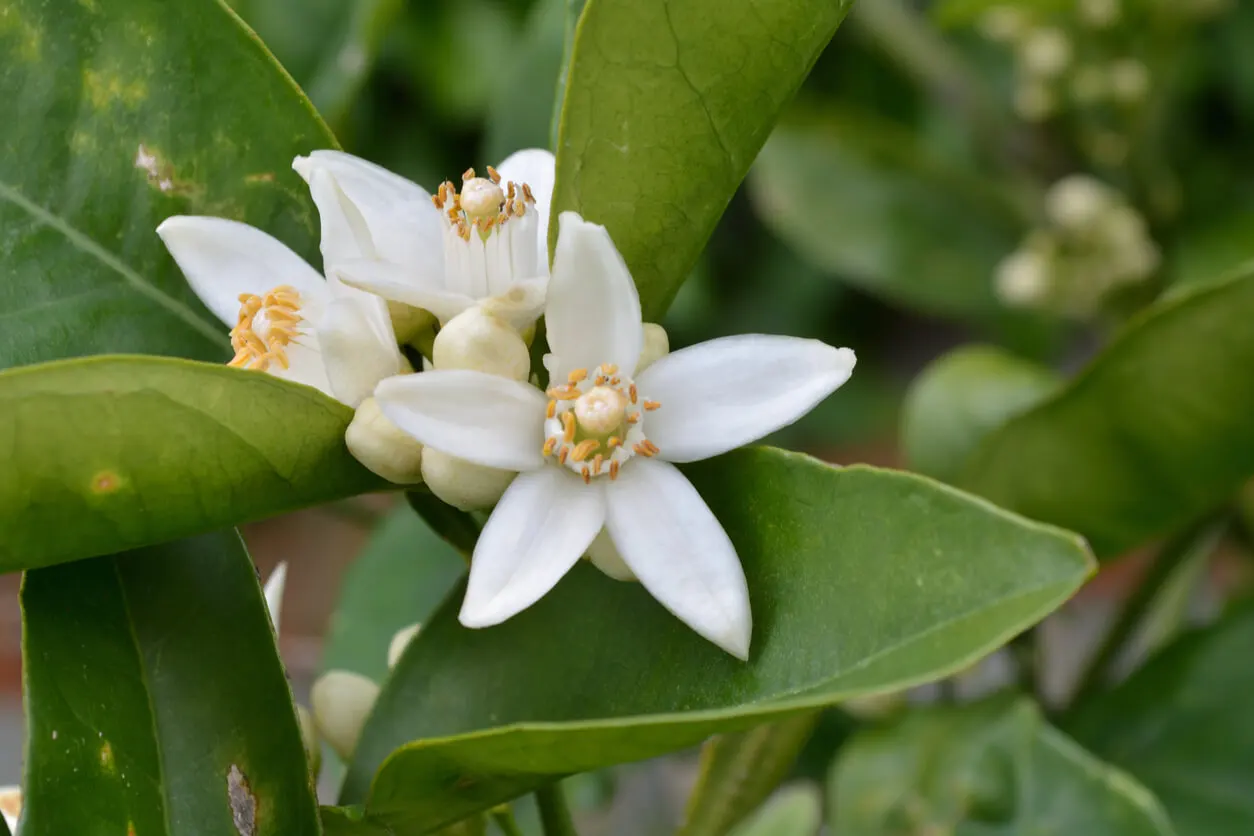Neroli Essential Oil: Uses, Benefits, and Contraindications


Reviewed and approved by the pharmacist Franciele Rohor de Souza
Neroli essential oil is a product obtained through steam distillation of the white, waxy flowers of the bitter orange tree (Citrus aurantium). It’s also known as “orange blossom oil” and is characterized by its mild floral aroma with hints of citrus.
Due to its composition and properties, it’s often used in both natural medicine and cosmetics. In particular, it’s attributed to anti-inflammatory, analgesic, antimicrobial, anxiolytic, and antioxidant potential. Do you want to know more about its benefits and contraindications? In this article, we’ll tell you all about them.
The uses and benefits of neroli essential oil
In traditional medicine, neroli essential oil has been used as an adjuvant against inflammation, pain, menopausal symptoms, and skin disorders. Its effects are largely attributed to its constituents, among which the following stand out:
- Limonene (27,5 %)
- (E)-nerolidol (17,5 %)
- Alpha-terpineol (14 %)
- Alpha-terpinyl acetate (11,7 %)
- (E,E)-farnesol (8 %)
The product is obtained from the fresh flowers of the bitter orange tree (Citrus aurantium), which must be harvested by hand without excessive bruising. Once plucked, processing should be done as soon as possible, as the blossoms tend to lose their oils.
To date, many of the applications of this oil are still based on anecdotal evidence. And while some scientific studies support certain properties, experts insist on the need for more data. Because of this, its use should be merely complementary. Let’s take a look at what it’s used for.
We think you may also enjoy reading this article: 20 Essential Oils You Should Have During the Winter
Inflammation and pain
Neroli essential oil has been used topically as an ally to reduce inflammation and pain. It’s believed that it can reduce symptoms of muscle injuries, joint disorders, and neuropathic pain.
However, for now, there are only studies done on animals.
In research on rats reported in the Journal of Natural Medicines, this oil helped decrease acute and chronic inflammation. In addition, it exhibited analgesic properties by reducing central and peripheral sensitivity to pain.
A study shared in the Journal of Agricultural and Food Chemistry reported that this product also has the potential against inflammation-associated diseases when used as a food additive.
Menopausal symptoms
In a randomized controlled trial, reported through Evidence-Based Complementary and Alternative Medicine, inhalation of neroli essential oil was found to be beneficial for women in the menopausal stage.
The reason? It helps to decrease the intensity of symptoms such as low sex drive, high blood pressure, and stress. According to observations, the product helps balance serum cortisol and estrogen concentrations.

Labor support
Aromatherapy with neroli essential oil has shown benefits for women in labor. In a study shared in the Iranian Red Crescent Medical Journal, a group of women about to give birth were given gauze pads soaked with this product. These were worn on the neck and renewed every 30 minutes.
The result of the research reported that the compounds in the oil helped stimulate the olfactory system and were helpful in decreasing anxiety during labor. The researchers labeled this as a “simple, inexpensive, non-invasive and effective intervention.”
Symptoms of premenstrual syndrome
It’s no coincidence that this variety of essential oil is listed as a “women’s health ally.” Popular literature describes its use in aromatherapy as a remedy to reduce PMS symptoms (pain and swelling).
A small study of young college girls reported that inhaling neroli essential oil helped reduce moodiness, pain, and swelling caused by PMS.
Anticonvulsant potential
In the traditional medicine of some Asian countries, neroli essential oil is used as a natural anticonvulsant. Its application is associated with a balance of the electrical activity of the brain and a decrease in tremors.
For the time being, there’s no evidence of these effects on humans. However, a rat study shared in Natural Product Communications found that biologically active compounds in C. aurantium (neroli) flower essential oil exert anticonvulsant activity.
Antimicrobial and antioxidant activity
The chemical composition of neroli essential oil confers antimicrobial and antioxidant qualities. In an in vitro investigation reported in the Pakistan Journal of Biological Sciences, this product exhibited antimicrobial activity against 6 types of bacteria, especially Pseudomonas aeruginosa.
It was also useful against two types of yeasts and three fungi. Among other things, it was found to have antioxidant potential, suggesting benefits against damage caused by oxidative stress.
Skin health and beauty
A wide variety of cosmetic skin care products contain neroli essential oil in their formulas. Due to its content of flavonoids, vitamins, minerals, and terpenoids, its topical use is linked to skin protection and prevention of premature aging.
Flavonoids, in particular, are linked to a photoprotective effect. Once assimilated, they help absorb ultraviolet light and prevent cellular aging.
In addition, its antimicrobial and antifungal qualities are linked to the prevention of acne and other skin infections. In turn, it nourishes the skin and promotes the healing process.

Safety and contraindications of neroli essential oil
In most cases, neroli essential oil is safe and well-tolerated. It’s often used in aromatherapy, massages, and topical remedies. Its direct ingestion is not recommended, although it may be industrially included in some products as a food additive without risk.
However, for safety reasons, this product should not be applied undiluted. It must be combined with a carrier oil (coconut, almond, olive, etc.) to avoid irritating the skin. In addition, it should not come into contact with mucous membranes.
Before applying any topical remedy with neroli essential oil, it’s advisable to perform a patch test on areas such as the forearm. If there are no negative reactions after a few hours, it can be applied without any problems.
It should be avoided in the following cases:
- Young children
- Open skin lesions
- Any skin exposed to direct sun or tanning beds
Like this article? You may also like to read: Helichrysum Essential Oil: Possible Benefits and Precautions of Use
Uses of neroli essential oil
Neroli essential oil can be purchased in herbalist stores or online. It is mainly used through diffusers, sprays, or during bathing.
As a soothing and relaxing oil, it can be applied on a cotton ball or on a handkerchief. Then, its aroma is inhaled.
To enhance its effect, it can be combined with one or more essential oils, such as the following:
- Chamomile
- Sage
- Frankincense
- Geranium
- Ginger
- Grapefruit
- Jasmine
- Juniper
- Lavender
- Lemon
- Tangerine
- Myrrh
- Orange
- Palmarosa
- Sandalwood
- Ylang ylang
For massages or skin treatments it’s necessary to combine it with a carrier oil. The proportions are usually 5 drops per 20 milliliters of carrier oil.
What to remember about neroli oil
Neroli essential oil is one of the three varieties of oils that can be obtained from the bitter orange tree (Citrus aurantium). In particular, it’s made by steam distillation of its fresh leaves. The result is a product abundant in antioxidants, ideal for skin care and the reduction of some ailments.
For now, studies supporting its efficacy are limited and have been done largely on animals and in the laboratory. In any case, it’s a safe ingredient that can be used as a supplement to reduce pain, anxiety, acne, and inflammation, among other conditions.
In addition, it’s frequently found in the formula of cosmetic products and herbal mixtures to reduce stress. Would you like to try it?
All cited sources were thoroughly reviewed by our team to ensure their quality, reliability, currency, and validity. The bibliography of this article was considered reliable and of academic or scientific accuracy.
- Ammar AH, Bouajila J, Lebrihi A, Mathieu F, Romdhane M, Zagrouba F. Chemical composition and in vitro antimicrobial and antioxidant activities of Citrus aurantium l. flowers essential oil (Neroli oil). Pak J Biol Sci. 2012 Nov 1;15(21):1034-40. doi: 10.3923/pjbs.2012.1034.1040. PMID: 24163946.
- Azanchi T, Shafaroodi H, Asgarpanah J. Anticonvulsant activity of Citrus aurantium blossom essential oil (neroli): involvment of the GABAergic system. Nat Prod Commun. 2014 Nov;9(11):1615-8. PMID: 25532295.
- Bonaccorsi I, Sciarrone D, Schipilliti L, Trozzi A, Fakhry HA, Dugo G. Composition of Egyptian nerolì oil. Nat Prod Commun. 2011 Jul;6(7):1009-14. PMID: 21834247.
- Choi SY, Kang P, Lee HS, Seol GH. Effects of Inhalation of Essential Oil of Citrus aurantium L. var. amara on Menopausal Symptoms, Stress, and Estrogen in Postmenopausal Women: A Randomized Controlled Trial. Evid Based Complement Alternat Med. 2014;2014:796518. doi: 10.1155/2014/796518. Epub 2014 Jun 12. PMID: 25024731; PMCID: PMC4082953.
- Domaszewska-Szostek A, Puzianowska-Kuźnicka M, Kuryłowicz A. Flavonoids in Skin Senescence Prevention and Treatment. Int J Mol Sci. 2021 Jun 25;22(13):6814. doi: 10.3390/ijms22136814. PMID: 34201952; PMCID: PMC8267725.
- Khodabakhsh P, Shafaroodi H, Asgarpanah J. Analgesic and anti-inflammatory activities of Citrus aurantium L. blossoms essential oil (neroli): involvement of the nitric oxide/cyclic-guanosine monophosphate pathway. J Nat Med. 2015 Jul;69(3):324-31. doi: 10.1007/s11418-015-0896-6. Epub 2015 Mar 12. PMID: 25762161.
- Namazi M, Amir Ali Akbari S, Mojab F, Talebi A, Alavi Majd H, Jannesari S. Aromatherapy with citrus aurantium oil and anxiety during the first stage of labor. Iran Red Crescent Med J. 2014 Jun;16(6):e18371. doi: 10.5812/ircmj.18371. Epub 2014 Jun 5. PMID: 25068058; PMCID: PMC4102991.
- Shen CY, Jiang JG, Zhu W, Ou-Yang Q. Anti-inflammatory Effect of Essential Oil from Citrus aurantium L. var. amara Engl. J Agric Food Chem. 2017 Oct 4;65(39):8586-8594. doi: 10.1021/acs.jafc.7b02586. Epub 2017 Sep 25. PMID: 28906110.
- Suntar I, Khan H, Patel S, Celano R, Rastrelli L. An Overview on Citrus aurantium L.: Its Functions as Food Ingredient and Therapeutic Agent. Oxid Med Cell Longev. 2018 May 2;2018:7864269. doi: 10.1155/2018/7864269. PMID: 29854097; PMCID: PMC5954905.
This text is provided for informational purposes only and does not replace consultation with a professional. If in doubt, consult your specialist.








